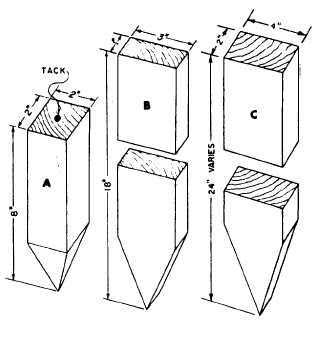are generally classified as field supplies. Because
SEABEEs operate in so many different places and
under such varied conditions, we have not tried
to list in this training manual the supply
requirements for every location. From your own
experience and with the aid of your leading petty
officer, you can easily make a list of supplies
necessary for a projected survey mission. Those
items generally required for a mission are
described in this section.
SURVEY POINT MARKERS
The material used as a SURVEY POINT
MARKER depends upon where the point is
located and whether the marker is to be of
a temporary, semipermanent, or permanent
character. For example, a wooden stake can be
easily driven to mark the location of a point in
a grassy field, but it cannot be used to mark a
point on the surface of a concrete highway.
Similarly, though a wooden stake may be easily
driven in a grassy field to mark a property line
corner, a marker of this kind would not last as
long as a piece of pipe or a concrete monument.
Most of the material commonly used as
semipermanent or permanent markers of points
in the field is described in the following sections.
For purely temporary marking, it is often
unnecessary to expend any marking materials. For
example, a point in ordinary soil is often
temporarily marked by a hole made with the point
of a plumb bob, a chaining pin, or some other
pointed device. In rough chaining of distances,
even the mere imprint of a heel in the ground may
suffice. A point on a concrete surface may be
temporarily marked by an X drawn with keel
(lumber crayon), a pencil, or some similar
marking device. A large nail serves well as a
temporary point in relatively stable ground or
compacted materials.
Semipermanent Markers
Wooden hubs and stakes are extensively used
as semipermanent markers of points in the field.
The principal distinction between the two is the
fact that a hub is usually driven to bring its top
flush with, or almost flush with, the ground
surface. A hub is used principally to mark the
station point for an instrument setup. It is usually
made of 2- by 2-in. stock and is from 5 to 12 in.
long. The average length is about 8 in. Shorter
lengths are used in hard ground, longer lengths
in softer ground. A surveyor’s tack, made of
galvanized iron or stainless steel with a depression
in the center of the head, is driven into the top
of the hub to locate the exact point where the
instrument is to be plumbed.
Stakes improvised in the field may be either
cylindrical or any other shape available. However,
manufactured stakes are rectangular in cross
section because the faces of a stake are often
inscribed with data relevant to the point that the
stake is marking. A stake that marks a bench
mark, for instance, is inscribed with the symbol
that identifies the bench mark and with the
elevation. A stake that marks a station on a
traverse is inscribed with the symbol of the
particular station, such as 2 + 45.06. A grade
stake is inscribed with the number of vertical feet
of cut (material to be excavated) or of fill (material
to be filled in) required to bring the elevation of
the surface to the specified grade elevation.
Figure 11-56 shows typical dimensions for an
average-sized hub and stake. These dimensions,
however, may be modified as situations arise, such
as material limitations.
Permanent Markers
Permanent station markers are used to mark
points that are to be used for a long period of
time. Horizontal and vertical control stations are
Figure 11-56.-Hub and stakes.
11-47



